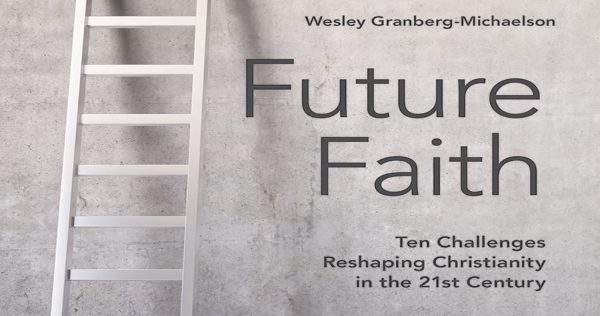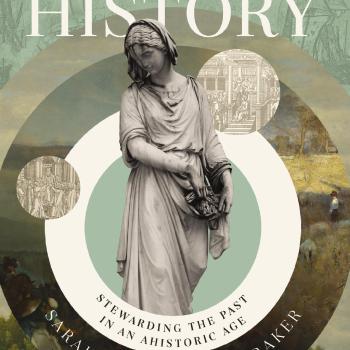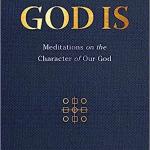Today we welcome David W. Congdon to the Anxious Bench. David is acquisitions editor at the University Press of Kansas, and author of The God Who Saves: A Dogmatic Sketch, two books on Rudolf Bultmann, and an edited volume on Karl Barth.
Wesley Granberg-Michaelson’s latest book, Future Faith: Ten Challenges Reshaping Christianity in the 21st Century, aims to be an accessible and practical introduction to what the new shape of the global church can teach US Christians. As the director of the Church and Society division of the World Council of Churches from 1988 to 1994 and then general secretary of the Reformed Church in America, Granberg-Michaelson writes books primarily for a mainline, broadly Reformed readership that has presumably remained insulated from the explosion of literature about world Christianity over the last two decades.
Future Faith looks at “ten challenges” for churches to address. These include the need to see Christianity with “non-Western eyes,” affirming Pentecostal or “Spirit-filled” communities, “de-Americanizing the gospel,” rejecting individualism, moving beyond the culture wars, and understanding salvation as inclusive of the present creation. None of this is particularly novel, of course; but the book is well-written, and taken in isolation, it has much to commend it. Granberg-Michaelson is gifted at weaving personal stories from his many years of experience into his argument for what Western Christianity needs to hear and embrace.
The problem is that no book exists in isolation, to the frequent chagrin of authors and publishers everywhere. In the case of Future Faith, it is impossible—at least for me and, I suspect, for many of its readers—to read this book without noticing connections to so many other titles, including, among many others, Philip Jenkins’s The Next Christendom, Mark Noll’s The New Shape of World Christianity, E. Randolph Richards and Brandon J. O’Brien’s Misreading Scripture with Western Eyes, Graham Hill’s GlobalChurch, and Soong-Chan Rah’s The Next Evangelicalism (Rah wrote the foreword to Future Faith).
Of course all books are part of an ongoing conversation, so that alone is hardly worthy of comment. What is of interest here is the implicit or explicit reason behind the explosion of this literature ever since Jenkins published his book in 2002. Many of these titles, and here Future Faith is paradigmatic, are interested in world Christianity because of a perceived deficiency in the so-called “Western” church that knowledge of the “non-Western” church can somehow rectify. The opening chapter of Granberg-Michaelson’s book begins by sketching this very contrast:
“On a Sunday after Easter, my wife Karin and I were in Tucson, Arizona, and went to worship at a Lutheran congregation, one of nearly ten thousand belonging to the Evangelical Lutheran Church in America. . . . But the sanctuary was less than half filled, with that familiar prominence of gray hair, and there was only a handful of souls in the choir. . . . From the looks of it, this congregation is dying. . . . At the Kensington Hotel in South Korea, across the street from the Yoido Full Gospel Church, the largest church in the world, I was discussing the future of Christianity with Scott Thumma. . . . So, the first challenge facing the future of Christianity, at least in the United States, is this: Most congregations must change or face a slow but certain demographic death.” (7-8, 12)
The passage begs to be questioned. Is the situation really this stark? Is it not borderline manipulative to cherry-pick a small ELCA congregation in Tucson and the largest church in the world for the sake of comparison? Moreover, is size really the mark of a thriving church and, by implication, is death really the mark of unfaithfulness? Should that small ELCA congregation strive to become Lakewood Church?
These are just a few of the questions this passage raises for me, but what concerns me here is the comparison between the dying Western church and the thriving non-Western church. This stark binary between the “bad West” and the “good non-West” is the structuring principle of Future Faith. In chapter 3 on “seeing through non-Western eyes,” Granberg-Michaelson identifies three distinct “lenses” through which the West and the non-West, respectively, see the world: (1) individual versus community, (2) rational vs. supernatural approaches to knowledge, and (3) the material world vs. the spiritual world. These different lenses then inform the following chapters.
Such a simplistic binary reminds me of Brian McLaren’s A New Kind of Christian, which had a table comparing modern and postmodern thought, arguing that we needed to move from one side of the table to the other side. And if Future Faith were simply comparing two philosophies, we could debate the merits of the distinction. But unlike the modern/postmodern binary, the West/non-West distinction intends to refer to geographically distinct peoples, cultures, and nations. What Granberg-Michaelson is suggesting is that the West needs to learn from (appropriate?) the non-West in order to persevere in the face of a changing world.
There is a kind of inverse colonialism at work here: instead of the West bringing civilization to the non-West, now the West brings (or needs the non-West to bring) non-Western “vitality” to the West in order to save itself.
Granberg-Michaelson concludes the first chapter on this very note:
The astonishing developments in Christianity around the world are becoming present in US society through the movements of migration. About two-thirds of immigrants coming to the United States are Christians, bringing with them the vitality, texture, and expressions of faith formed in non-Western cultures. . . . The question is whether US churches will be locked into a parochial story of their gradual demise or liberated by a global story that is bringing new life into its midst from unexpected places. (19-20)
Future Faith is by no means the only book to suggest that the future of Western Christianity is in becoming more non-Western. I could have written this about any number of other books, but Future Faith is the one that crossed my desk.
While Future Faith is not exactly a bad book, it participates—perhaps unwittingly—in what we might call the “global-church industrial complex.” By this I mean the industry of books, sermons, lectures, conferences, summits, and missions that seek to mine the resource of “non-Western Christianity” for the sake of fixing “Western Christianity.”
For several years I was an editor at InterVarsity Press, where I encountered numerous books with the same premise. Evangelicals are especially enthralled with this genre, and not only because of their long-standing interest in mission. The global church holds a special interest to many evangelicals today because they view the non-Western church as a more authentic version of Christianity, one that is in closer proximity to the raw, supernatural, persecuted faith of the first century—over against the secular, materialistic, hedonistic character of Western society. When you’re fighting a culture war, it helps to have numbers on your side—and 600 million non-Western Pentecostals can’t hurt.
But that is precisely the danger in all this. The “non-Western Other” becomes an object used by Western Christians to serve their own ends. Many of these books—including Future Faith, unfortunately—have a tendency to fetishize and romanticize non-Western Christianity.
Jason Bruner, in a recent essay about one of the evangelical books in the global-church industrial complex, comments on the “evangelical search for authenticity” displayed in works of this nature. He points out that “these American searches for authentic Christianity have something of the furtive voyeuristic glances of dispassionate lovers, longing to recover with another that which they had once shared.”
In a kind of reverse Orientalism, these books essentialize the non-Western as superior in static and superficial terms. The evangelicals essentialize the non-West as more orthodox, more persecuted, and more mission-minded. Granberg-Michaelson essentializes the non-West as more dynamic, more spiritual, more communal, and more connected to God’s creation. Both argue that the non-West is more ancient and original. According to Future Faith, “fresh expressions of such ancient faith are more likely to find fertile soil in the non-Western cultures that are the context for Christianity’s future” (233).
Both the evangelicals and Granberg-Michaelson use the same dichotomizing and essentializing rhetoric to achieve slightly different goals. The major difference is that Granberg-Michaelson sees the non-West as defeating the culture wars, whereas the evangelicals see the non-West as their allies in the culture wars.
While I agree with many of Granberg-Michaelson’s goals in Future Faith, the ends do not justify the means—and the means in this case is an essentializing binary that stereotypes both the West and the non-West and reinforces a colonial gaze that sees world Christianity largely as a resource for the Western church to mine.
Not all of the books in the global-church industrial complex are liable to this critique. Some are helpfully informative about the changing nature of Christianity today. But too many of the books and products about the global church participate in yet another form of coloniality, and it is time we scrutinize this literature for the way it further entrenches us in what Willie James Jennings calls “modern Christianity’s diseased social imagination.”

















